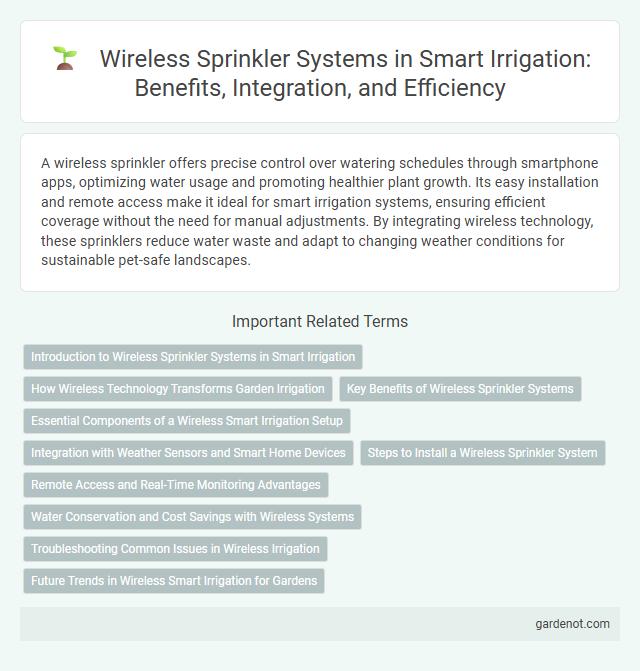A wireless sprinkler offers precise control over watering schedules through smartphone apps, optimizing water usage and promoting healthier plant growth. Its easy installation and remote access make it ideal for smart irrigation systems, ensuring efficient coverage without the need for manual adjustments. By integrating wireless technology, these sprinklers reduce water waste and adapt to changing weather conditions for sustainable pet-safe landscapes.
Introduction to Wireless Sprinkler Systems in Smart Irrigation
Wireless sprinkler systems in smart irrigation utilize advanced wireless communication technologies such as Wi-Fi, Zigbee, or Bluetooth to enable remote control and automation of watering schedules. These systems integrate with soil moisture sensors, weather data, and IoT platforms to optimize water usage, reduce waste, and promote sustainable landscaping practices. By replacing traditional wired connections, wireless sprinklers offer flexible installation, real-time monitoring, and adaptive irrigation management for residential and commercial applications.
How Wireless Technology Transforms Garden Irrigation
Wireless technology revolutionizes garden irrigation by enabling precise control and monitoring of sprinklers through smartphone apps or remote devices, reducing water waste and improving plant health. Sensors integrated with wireless systems collect real-time data on soil moisture, weather conditions, and plant needs, allowing automated adjustments to watering schedules. This smart approach enhances efficiency, conserves water resources, and supports sustainable gardening practices.
Key Benefits of Wireless Sprinkler Systems
Wireless sprinkler systems offer precise water distribution by using sensors and real-time weather data, optimizing irrigation efficiency and reducing water waste. These systems enable remote control and scheduling via smartphones, enhancing convenience and allowing tailored watering schedules to promote healthy plant growth. Integration with smart home platforms provides seamless automation, saving energy and lowering water bills while maintaining a lush landscape.
Essential Components of a Wireless Smart Irrigation Setup
A wireless smart irrigation setup includes essential components such as a sensor network for real-time soil moisture and weather data collection, a central control unit that processes environmental inputs, and wireless sprinkler valves that receive commands for precise water distribution. These elements work together to optimize water usage, enhance plant health, and reduce wastage by adapting irrigation schedules based on current conditions. Integration with smartphone apps or cloud platforms enables remote monitoring and control, ensuring efficient and sustainable landscape management.
Integration with Weather Sensors and Smart Home Devices
Wireless sprinklers seamlessly integrate with weather sensors to automatically adjust watering schedules based on real-time environmental data, optimizing water usage and promoting plant health. Compatibility with smart home devices, such as voice assistants and automation hubs, allows users to control and monitor irrigation remotely, enhancing convenience and efficiency. This integration ensures precise watering management, reducing water waste and supporting sustainable gardening practices.
Steps to Install a Wireless Sprinkler System
Start by selecting a suitable wireless sprinkler controller compatible with your irrigation zones and water source. Next, install the wireless valves at each sprinkler station, ensuring they are securely connected to the water lines and power supply if required. Finally, configure the controller settings via the app or device interface, calibrate sprinkler zones for coverage optimization, and test the system to confirm wireless signals and watering schedules function correctly.
Remote Access and Real-Time Monitoring Advantages
Wireless sprinklers enable remote access through smartphone apps, allowing users to control watering schedules from anywhere, optimizing water usage. Real-time monitoring features track soil moisture and weather conditions to adjust irrigation automatically, preventing overwatering and conserving resources. These technologies enhance garden health and reduce water waste by providing precise, data-driven irrigation management.
Water Conservation and Cost Savings with Wireless Systems
Wireless sprinkler systems enhance water conservation by utilizing precise moisture sensors and weather data to deliver optimal irrigation only when necessary. These smart systems reduce water waste, lowering utility bills and minimizing the environmental impact. Cost savings are further achieved by eliminating the need for extensive wiring and simplifying installation and maintenance processes.
Troubleshooting Common Issues in Wireless Irrigation
Wireless sprinkler systems may experience connectivity interruptions due to interference from nearby electronic devices or physical obstacles obstructing signal transmission. Battery depletion in wireless controllers often leads to system malfunctions, requiring regular monitoring and timely replacement to maintain optimal performance. Signal range limitations can cause inconsistent watering patterns, which can be resolved by repositioning the transmitter or installing signal repeaters to ensure comprehensive coverage.
Future Trends in Wireless Smart Irrigation for Gardens
Wireless sprinklers integrate advanced IoT sensors and AI algorithms to optimize water usage, reducing waste by up to 40% compared to traditional systems. Future trends emphasize enhanced connectivity through 5G networks and edge computing for real-time soil moisture analysis and adaptive irrigation scheduling. Growing adoption of solar-powered wireless sprinklers supports sustainable energy use while improving garden health and automation efficiency.
Wireless sprinkler Infographic

 gardenot.com
gardenot.com